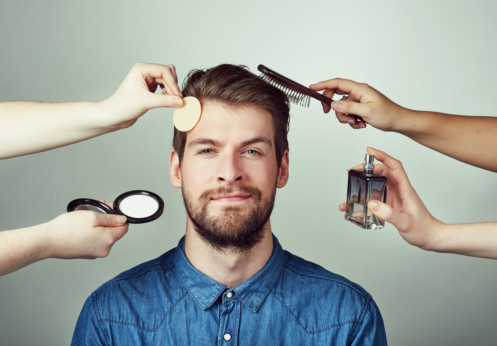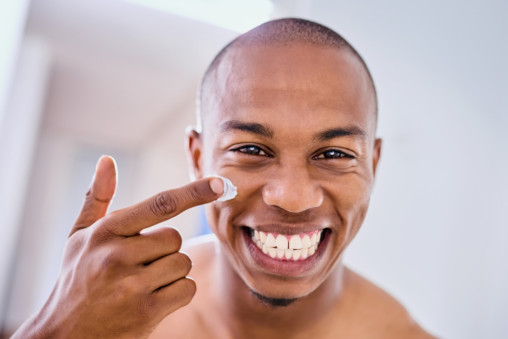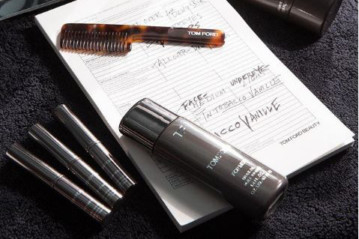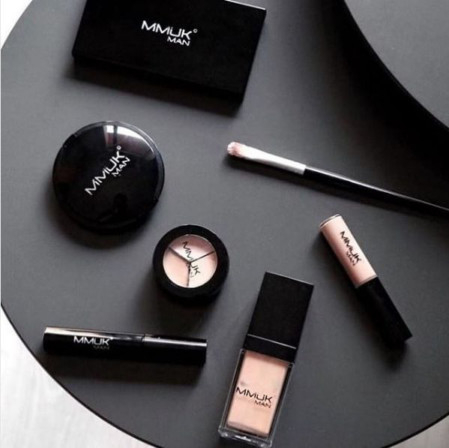
I’m looking at the man in the mirror. And he looks great, to be honest. It’s how I feel I should look, when I am at my most optimistic. There’s a smooth sheen across my cheeks. My eyes are bright, my brows orderly.
And the reason I look so good? Because a make-up artist has spent 40 minutes on my face. First, she dowsed it with Hollywood Flawless Filter by Charlotte Tilbury. Later, I look it up: it says it’s “a customisable complexion booster” with “the versatility of a primer” and “the mega-watt glow of a highlighter”. Next, she added blobs of what looks like green toothpaste across my cheeks. I am briefly horrified; does she want me to look like Grotbags? But it gets rid of all my blotchy redness. Who knew?
Women know, obviously. For the last century, make-up has been mostly the preserve of just half the population. Even as society has become more feminist, and less ruled by gender binaries, women’s cosmetics use has become even more prolific, while men have continued to go au naturel, occasionally boshing on a bit of moisturiser and hoping for the best.
But that may be changing, as brands from Chanel to Tom Ford launch male cosmetics lines, which is why I’ve asked for a makeover.
Mirror, mirror...
My new “natural” look involves about 11 different products. The first round of five or so I recognise: toners, moisturisers, a calming face mist. Nothing girlie about that, I think. This is just skincare; my bathroom cabinet is full of this nonsense. Then comes the foundation, filter, powder, two different kinds of colour correction, concealer, eyebrow brush and lip gloss.
Sam Cooper, who has prepped stars from Tony Hadley to Jon Hamm for photoshoots and big nights out, seems trustworthy, but surely all of this is going to make me look like Gemma Collins. I am wrong. When Cooper is finished, I look properly in the mirror, and like what I see. I feel like a child who has just discovered how the magician does his tricks.
For an increasing number of men, make-up is becoming the norm. Tom Ford launched a men’s concealer and brow gel comb last year; Chanel now has a tinted foundation, a matt lip balm and four shades of eyebrow pencil under its new Boy De Chanel brand. Male cosmetics still make up less than 1 per cent of the $465 billion (Dh1.7 trillion) global beauty market, although 15 per cent of UK men under 45 bought make-up in 2016 (the figures don’t say whether this was for personal use).
Who’s leading the change
As with the boom in female beauty, the charge is being led by ordinary teenagers making videos in their bedrooms. James Charles from upstate New York was 16 when he launched his first make-up tutorial on YouTube. In it, he demonstrates how to do a complex contoured look with a deep blue eyeshadow glow, completely transforming his face. By the age of 18, Charles had amassed 8.5 million subscribers and become the first man to model for make-up brand CoverGirl.
In the UK, the most famous male beauty vlogger is Gary Thompson, who has had campaigns with L’Oreal and Superdrug. His Instagram handle is @theplasticboy, and there is a certain Ken doll sheen to his contoured cheeks. He started wearing make-up because of bad skin, but now loves the way it makes him feel. He says things have changed a lot in the time he’s been wearing make-up. “I remember walking down the street in a full beat [full make-up look] and getting dirty looks, but now no one blinks an eye.”
Both Thompson and Charles are model-like, and their make-up looks are full-on and feminine: lots of contouring, bronzer and colour. The question, though, is whether high-profile vloggers doing deals with mainstream beauty brands could signal a tipping point where male make-up becomes more commercially viable.
Bunny Kinney, editor of Dazed Beauty magazine, tells me he’s starting to hear major brands talk about male make-up, but that there’s a long way to go before men start powdering their noses before a night out. “In spite of all the amazing, radical progress that’s being made with regards to gender nonconformity, beauty still very much exists on that mainstream binary. For things like male foundation, getting rid of that stigma is going to be hard.”
The brands are coming
One brand believes it can beat the knee jerk unease men have about make-up. It’s called MMUK. On sale exclusively through Asos, it has grown to become the biggest male-focused make-up brand in Europe, with a turnover last year of £1 million.
MMUK is based in Brighton, where I meet its founder, Alex Dalley. After watching plenty of beauty vlogs, I have certain preconceptions, so I am surprised to be greeted by a man in a plain white T-shirt and black exercise shorts that expose his tree-trunk, rugby-player legs.
Dalley says his interest in make-up started when he was a teenager: he is blind in one eye and had terrible acne, and would regularly miss school because he didn’t want anyone to see his visible disability. “I’m surprised I ever left my bedroom,” he says.
On the night of the lower-sixth prom, his mother convinced him to try foundation. The result was life-changing. “I remember looking in the mirror and feeling like myself again,” Dalley says. It kick-started a fascination with bronzers and concealers, although he remained too frightened to buy anything himself, sending his mum off to Boots to shop for him.
While studying business at Sussex University, he did some market research and was surprised to find there weren’t any male beauty brands. He began developing a business plan, and when he left university, tried to make it a reality, setting up a website and using his overdraft to buy up cheap, discontinued Calvin Klein women’s make-up, which he then marketed at men.
Straight away, Dalley was making more than £1,000 a month by convincing men they were buying male make-up when they weren’t. He included tutorials and guides, showing men the basics of foundation, powder and concealer (his site was also the first that came up if you Googled “make-up for men”). Eventually, he ran out of the Calvin Klein stock, so he started investing in his own products.
“We thought gay men would find less of a stigma around it, because they are more open,” he says. “But a lot of the men who were getting in contact were straight. There were in their 40s struggling with wrinkles, worried about younger people coming through at work, wanting to show their bosses they still had energy. There were also men in their 30s, worried about dark circles. And then a huge number of teenagers trying to deal with acne, maybe 40 per cent of our customers.”
MMUK changed the tone of the language on the website, and took out references to nights out and “wingmen” to make it appealing to all age groups, and watched the business grow. In 2017, it got a distribution deal with Asos; Dalley now plans to expand into 12 new territories next year.
He says the success of the products is down to their formulations, which are different from women’s brands. They need to last longer, because there’s no way men will keep make-up in their bag or touch up in the bathroom (many of MMUK’s customers request the make-up to be delivered in plain packaging or addressed to a female name). Most importantly, each product is essentially designed to be invisible. The foundations are matt and come in a wide range of skin tones and types. The lip glosses are clear; the bronzers aim to make you look tanned, rather than to glow.
One for the men
I wonder how Dalley feels about the market expanding, with bigger brands muscling in on his turf. “I think Chanel, Tom Ford — they’re tokens. It’s all just marketing. They’ve just added the word ‘boy’ or ‘for men’. They haven’t had the balls to say, ‘Let’s really step away and create a whole range.’”
Thompson, who vlogs mostly about using women’s make-up to achieve his looks, agrees, adding that, just as female ranges have for decades given women of colour few options, these nascent ranges for men don’t cater for darker skin types. “With Chanel, it’s amazing that they are doing a men’s make-up range, but those shades? Why even bother if you don’t cater to all the men around the world?”
















